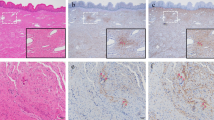Abstract
The aim of this study is to compare the levels of estrogen receptor (ER), progesterone receptor (PR), p53 and p21 between pelvic organ prolapse (POP) and control groups in order to evaluate their roles in pathogenesis of POP, and to find out the relationship among these proteins. Through the year of 2002, uterosacral ligaments were obtained from 20 prolapsus and 24 non-prolapsus hysterectomized uteruses. ER, PR, p53, and p21 proteins were extracted by Western blot analysis and relative levels of proteins were compared by Student t-test and Pearson correlation coefficient. P value <0.05 was considered statistically significant. All patients were postmenopausal and had never taken hormone replacement therapy. ER, PR, p53, and p21 were significantly lower in the study than control group (p<0.0001). Positive correlations were found among all proteins in the prolapse group. Further researches are needed to elucidate the interrelationship among these proteins and their precise roles in pathogenesis of POP.


Similar content being viewed by others
References
Ulmsten U, Ekman G, Giertz G, Malmstrõm A (1987) Different biochemical composition of connective tissue in continent and stress incontinent women. Acta Obstet Gynecol Scand 66:455–457
Norton PA (1993) Pelvic floor disorders: the role of fascia and ligaments. Clin Obstet Gynecol 36:926–938
Mokrzycki ML, Mittal K, Smilen SW, Blechman AN, Porges RF (1997) Demopolous RI Estrogen and progesterone receptors in the uterosacral ligament. Obstet Gynecol 90:402–404
Smith P, Heimer G, Norgren A, Ulmsten U (1993) Localization of steroid hormone receptors in the pelvic muscles. Eur J Obstet Gynecol Reprod Biol 50:83–85
Lang JH, Zhu L, Sun ZJ, Chen J (2003) Estrogen levels and estrogen receptors in patients with stress urinary incontinence and pelvic organ prolapse. Int J Gynecol Obstet 80:35–39
Zhang J, Salamonsen LA (2002) In vivo evidence for active matrix metalloproteinases in human endometrium supports their role in tissue breakdown at menstruation. J Clin Endocrinol Metab 87:2346–2351
McIntush EW, Smith MF (1998) Matrix metalloproteinases and tissue inhibitors of metalloproteinases in ovarian function. Rev Reprod 3:23–30
Brincat M, Versi E, Moniz CF, Magos A, de Trafford J, Studd JW (1987) Skin collagen changes in postmenopausal women receiving different regimens of estrogen therapy. Obstet Gynecol 70:123–127
Jackson SR, Avery NC, Tarton JF et al (1996) Changes in metabolism of collagen in genitourinary prolapse. Lancet 347:1658–1661
Moalli PA, Klingensmith WL, Meyn LA, Zyczynski HM (2002) Regulation of matrix metalloproteinase expression by estroen in fibroblasts that are derived from the pelvic floor. Am J Obstet Gynecol 187(1):72–79
Yamamoto M, Aoyagi M, Akazawa K, Tajima S, Yamamoto K (1998) Decrease in p53 protein in cultured cardinal ligament fibroblasts from patients with prolapsus uteri. Cell Bio Int 22(1):31–40
Bump RC, Mattiasson A, Bo K, Brubakes LP, DeLancey JO, Klarskov P et al (1996) The standardization of terminology of female pelvic organ prolapse and pelvic floor dysfunction. Am J Obstet Gynecol 175:10–17
Ewies A, Al-Azzawi F, Thompson J (2003) Changes in extracellular matrix proteins in the cardinal ligaments of postmenopausal women with or without prolapse: a computerized immunohistomorphometric analysis. Hum Reprod 18:2189–2195
Smith P, Heimer G, Norgren A, Ulmsten U (1990) Steroid hormone receptors in pelvic muscles and ligaments in women. Gynecol Obstet Invest 30:27–30
Finlay CA, Hinds PW, Levine AJ (1989) The p53 protooncogene can act as a suppressor of transformation. Cell 57:1083–1093
Baker SJ, Markowitz S, Fearon ER, willson JKV, Vogelstein B (1990) Suppression of human colorectal carcinoma cell growth by wild-type p53. Science 249:912–915
Diller L, Kassel J, Nelson CE, Gryka MA, Litwak G, Gebhardt M, Bressac B, Ozturk M, Baker SJ, Vogelstein B, Friend SH (1990) p53 functions as a cell cycle control protein in osteosarcomas. Mol Cell Biol 10:5772–5781
Nakanishi M, Adami GR, Robetorye RS, Noda A, Nenable SF, Dimitrov D, Pereira-Smith OM, Smith JR (1995) Exit from G0 and entry into the cell cycle of cells expressing p21Sdi1 antisense RNA. Proc Natl Acad Sci USA 92:4352–4326
Bai SW, Choe BH, Kim JY, Park KH (2002) Pelvic organ prolapse and connective tissue abnormalities in Korean women. J Reprod Med 47:231–234
Geldenhuys FG (1950) Genital prolapse in the Bantu. S Afr Med J 1950; 24:749–751
Author information
Authors and Affiliations
Corresponding author
Additional information
This study was supported by Yonsei University Research Fund of 2000 (2000-1-0225)
Rights and permissions
About this article
Cite this article
Bai, S.W., Chung, D.J., Yoon, J.M. et al. Roles of estrogen receptor, progesterone receptor, p53 and p21 in pathogenesis of pelvic organ prolapse. Int Urogynecol J 16, 492–496 (2005). https://doi.org/10.1007/s00192-005-1310-9
Received:
Accepted:
Published:
Issue Date:
DOI: https://doi.org/10.1007/s00192-005-1310-9




